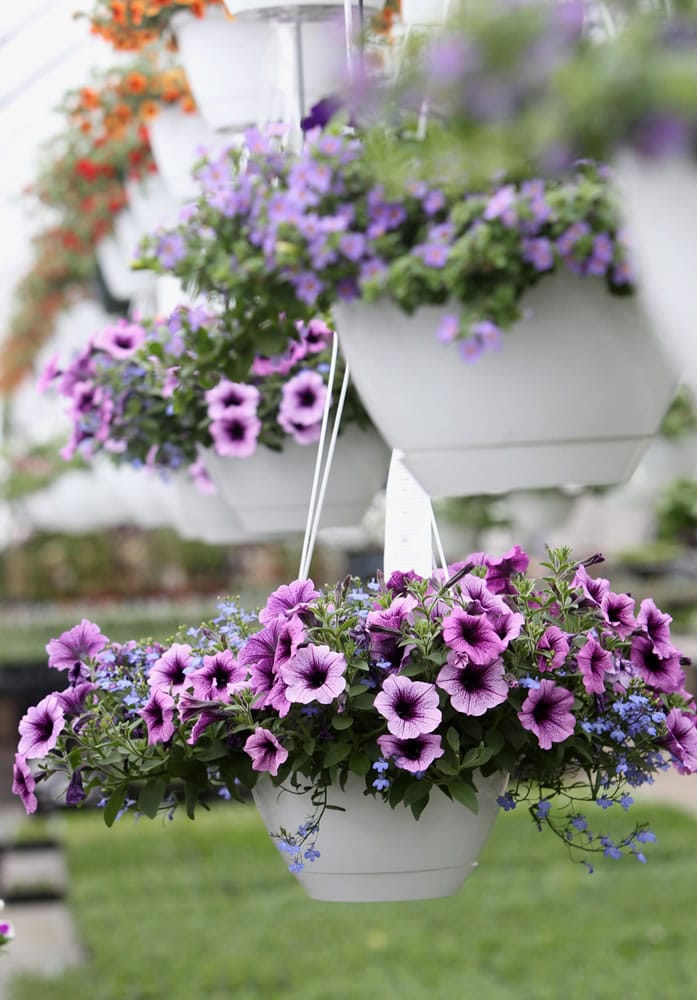Want to keep your hanging baskets looking great all season? Pete Kern and Pamela Crawford offer these tips:
• Water correctly. Overwatering is just killing a plant with kindness. Plants need water, but their roots also need oxygen. They can't get it when they're waterlogged.
Both Kern and Crawford say you should make sure the soil is somewhat dry before you add water. Crawford does it by sticking her finger into the soil. Kern judges by feeling the weight of the pot.
Water thoroughly, until the water runs out the bottom of the container. Kern recommended using a container such as a milk jug or a hose without a spray attachment, so you water just the soil, not the leaves. Wet leaves invite sun damage and disease.
It's best to water in the morning, when it's still cool, he said.
When heavy rains are forecast for four days or more, he recommended moving the plants to a sheltered spot.
• Water enough. Overwatering is a bad thing, but so is underwatering. Kern said you should never let your plants dry out to the point they wilt. If you do, they'll take weeks to rebound.
That might mean watering more than once a day during hot spells, particularly if the basket is small or in a windy or sunny spot.
If water runs right out the bottom of the pot just seconds after you start to water, it's a sign the soil is too dry, Kern said. Dried-out soil shrinks, creating a gap between the soil and the container. Water just flows down through that gap and out of the pot instead of reaching the plant roots.
Should that happen, Kern recommended watering the basket repeatedly until the soil has expanded and the basket becomes heavy.
• Fertilize. Kern is a big believer in frequent fertilization for hanging baskets. Besides adding slow-release fertilizer to the soil when he plants, he also recommends supplementing with a liquid fertilizer.
Early in the season when the plants are young, fertilize weekly, he said. Once the roots fill the pot, around July or August, he recommends stepping up to two or three fertilizations a week.
Generally, he likes an all-purpose fertilizer such as Miracle-Gro, although he suggested switching to a fertilizer with more phosphorus if the plants aren't blooming well. Don't overdo, though, or you can burn the plants, he said.
Crawford, on the other hand, thinks once is enough. She's choosy about the slow-release fertilizer she uses at planting time, Dynamite Premium Fertilizer for flowers and vegetables. That particular product lasts nine months, she maintained, so there's no need for additional feeding during that time.
• Rotate. Often hanging baskets are hung on a porch or other site where they're exposed to sunlight on only one side. In that case, Crawford said it's important to rotate the baskets for even growth.
She suggested hanging the baskets from swivel hooks, which you can buy at a hardware store.
• Deadhead if necessary. Most plants commonly used in hanging baskets don't need deadheading, which means removing their spent flowers. But some plants, such as daisies and verbena, do. Deadhead those plants regularly to ensure they'll keep blooming, Kern said.
• Pinch back. It can be hard to bring yourself to pinch back plants when they look good, but doing so will prevent those that need it from getting leggy.
Plants are just like hair, Crawford said. Just as you wouldn't wait till your hair is shaggy and unmanageable before getting it trimmed, neither should you wait till your plants look straggly before pinching them back.
Kern said July 4 is a good target date for cutting plants back a couple of inches. Crawford is guided more by appearance. When plants get leggy or uneven, she trims off the unwanted portions with her fingers or pruning shears.



